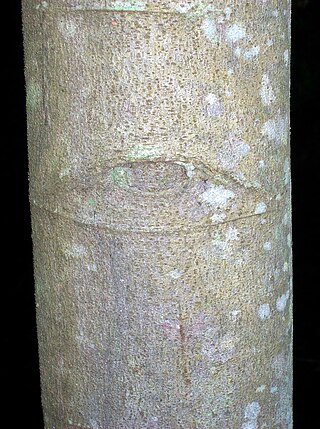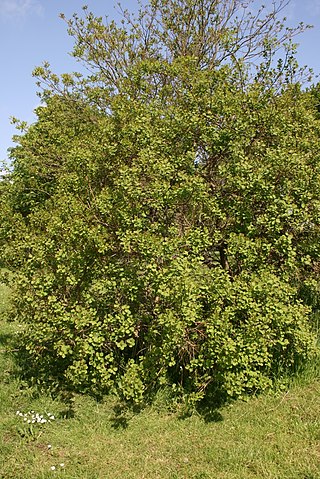
Forsythia, is a genus of flowering plants in the olive family Oleaceae. There are about 11 species, mostly native to eastern Asia, but one native to southeastern Europe. Forsythia – also one of the plant's common names – is named after William Forsyth.

Nelumbo lutea is a species of flowering plant in the family Nelumbonaceae. Common names include American lotus, yellow lotus, water-chinquapin, and volée. It is native to North America. The botanical name Nelumbo lutea Willd. is the currently recognized name for this species, which has been classified under the former names Nelumbium luteum and Nelumbo pentapetala, among others.

Glyptostrobus pensilis, known in Chinese as 水松, and also Chinese swamp cypress, is an endangered conifer, and the sole living species in the genus Glyptostrobus.

Weigela is a genus of between six and 38 species of deciduous shrubs in the family Caprifoliaceae, growing to 1–5 m (3–15′) tall. All are natives of eastern Asia. The genus is named after the German scientist Christian Ehrenfried Weigel.

Rhaphiolepis is a genus of about fifteen species of evergreen shrubs and small trees in the family Rosaceae, native to warm temperate and subtropical East Asia and Southeast Asia, from southern Japan, southern Korea and southern China, south to Thailand and Vietnam. In searching literature it is well to remember that the name commonly is misspelt "Raphiolepsis". The genus is closely related to Eriobotrya (loquats), so closely in fact, that members of the two genera have hybridised with each other; for example the "Coppertone loquat" is a hybrid of Eriobotrya deflexa X Rhaphiolepis indica. The common name hawthorn, originally specifically applied to the related genus Crataegus, now also appears in the common names for some Rhaphiolepis species. For example, Rhaphiolepis indica often is called "Indian hawthorn", and Rhaphiolepis umbellata, "Yeddo hawthorn".

Castanea pumila, commonly known as the Allegheny chinquapin, American chinquapin or dwarf chestnut, is a species of chestnut native to the southeastern United States. The native range is from Massachusetts and New York to Maryland and extreme southern New Jersey and southeast Pennsylvania south to central Florida, west to eastern Texas, and north to southern Missouri and Kentucky. The plant's habitat is dry sandy and rocky uplands and ridges mixed with oak and hickory to 1000 m elevation. It grows best on well-drained soils in full sun or partial shade.

Takenoshin Nakai was a Japanese botanist. In 1919 and 1930 he published papers on the plants of Japan and Korea, including the genus Cephalotaxus. During the Japanese occupation of the (former) Dutch East Indies Takenoshin Nakai was between 1943 and 1945 the director of 's Lands Plantentuin in Batavia (now: Bogor Botanical Gardens in Bogor.

Itaya amicorum is a medium-size fan palm that is native to Brazil, Colombia and Peru. It is the only species in the genus Itaya. It was unknown to science until 1972, when it was discovered on the bank of the Itaya River in the Peruvian Amazon.

Acer miyabei is a species of maple native to Japan, where it occurs in Hokkaidō and the Tōhoku region in northern Honshū.

Atractocarpus chartaceus, commonly known as the narrow-leaved gardenia, is a species of evergreen flowering plant in the coffee family Rubiaceae. It is found in subtropical rainforest of eastern Queensland, Australia, and it is cultivated for its fragrant flowers and colourful fruit.
Dypsis brevicaulis is a species of flowering plant in the Arecaceae family. It is a dwarf palm found on only three sites in Madagascar, with fewer than fifty plants ever found in the wild. The plant is part of the IUCN Sampled Red List Index for Plants, a study of representative species from all over the world which is studying extinction trends for plants.

Alphitonia petriei, commonly known as the white ash, is a rainforest tree in the family Rhamnaceae from eastern and northern Australia. Other common names include red ash, white-leaf, pink almond and pink ash. It was originally collected from the Johnstone River in October 1917 by H. Ladbrook, but the designated type for this species was collected by Cyril Tenison (C.T.) White in March 1922 from the Barron River near Kuranda. It was described and named in 1925 by K.W. Braid and White who assigned the species epithet petriei in honour of W.R. Petrie, who alerted them to its distinctness.

Lespedeza thunbergii is a species of flowering plant in the legume family known by the common names Thunberg's bushclover, Thunberg's lespedeza, and shrub lespedeza. It is native to the eastern Himalayas, China, Korea, and Japan.

Chrysophyllum oliviforme, commonly known as the satinleaf, is a medium-sized tree native to Florida, the Bahamas, the Greater Antilles, and Belize. It is also known as damson plum, wild star-apple and saffron-tree. It gets the name "satinleaf" from the distinctive colors of the leaves. The top of the leaf is dark green while the bottom is light brown or copper. This distinctive look makes it a very aesthetically pleasing tree that is commonly used as an ornamental in yards and public spaces.

Cotinus obovatus syn. C. americanus, the American smoketree, chittamwood or American smokewood, is a rare species of flowering plant in the genus Cotinus of the family Anacardiaceae, native to scattered locations in Oklahoma, Texas, Arkansas, Missouri, Alabama and Tennessee. It is a deciduous, conical shrub growing to 10 m (33 ft) tall by 8 m (26 ft) broad, with oval leaves up to 12 cm (5 in) long. It produces panicles of pink-grey flowers in summer, and its foliage turns a brilliant scarlet in autumn; considered by many to be the most intense fall color of any tree. The smokey effect derives from the clusters of hairs on the spent flower stalks. It is highly sought after and cultivated in botanical gardens worldwide. It is dioecious, with male and female flowers on separate plants.

The flora of North Korea has much in common with that of other areas of the northern hemisphere. 2898 species have been recorded, of which 14% are endemic. Four are classified as threatened.
Iris odaesanensis is a beardless iris in the genus Iris, in the subgenus Limniris and in the series Chinenses of the genus. It is a rhizomatous herbaceous perennial from China and eastern Korea. It has blue-green grass-like leaves, short stem, 1 or 2 fragrant, white or off-white flowers in spring to early summer. It is a rare plant in the wild, but it is cultivated in east Asia.

Gardenia actinocarpa is a rare and endangered plant in the coffee and gardenia family Rubiaceae, native to a very restricted area within the Wet Tropics rainforest of northeastern Queensland.

Forsythia europaea, commonly known as Albanian forsythia or European forsythia, is a species of flowering plant in the olive family, with a native range from Montenegro to northern Albania. It is the only species of Forsythia native to Europe; prior to its discovery in Albania in 1897, it was thought that all Forsythia were native to East Asia.

Forsythia ovata, the Korean forsythia or early forsythia, is a species of flowering plant in the family Oleaceae, native to the Korean Peninsula. An early bloomer, it is deer resistant, and hardy to −50 °F (−46 °C); USDA Hardiness zone 2a.




















